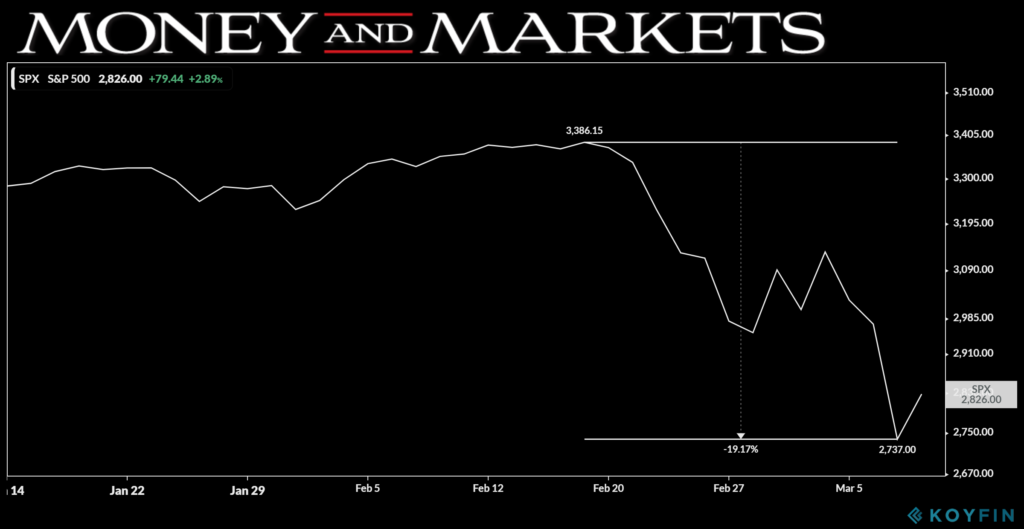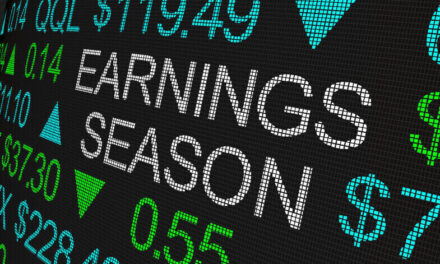It hasn’t happened since the last one ended in 2009 but after recent sell-offs, the U.S. stock market is close to entering bear market territory and newer investors may be asking: What is a bear market? In addition to answering that question, we also have some tips on investing when the bear officially returns.
America’s longest bull market turned 11 years old this month.
However, the spread of the coronavirus has put a continued run in serious jeopardy. Global markets are teetering on the brink of a recession.
Since closing at an all-time high of 3,386.15 on Feb. 19, 2020, the S&P 500 has fallen dangerously close to bear market territory.

Both the Dow Jones Industrial Average and the Nasdaq are also lingering just above 20% losses since early February.
What Is a Bear Market?
I’ve mentioned 20% for a reason.
To constitute a bear market, any asset class — stocks, bonds, currency, gold and commodities — must fall 20% from its recent 52-week high.
Take the S&P 500 for example. Its 52-week high was set back on Feb. 19, 2020, at 3,386.15. If it drops to 2,708.92, that would be a 20% drop in relatively short order. Thus, a bear market ensues.
Bear markets have occurred when major indexes drop over time. They hit new lows and their highs are much lower than before.
Typically, with bear markets come recessions followed by layoffs and high unemployment rates.
Triggering the Bear
Bear markets are usually sparked by a big drop in investor and consumer confidence. When confidence goes down, demand follows.
Pessimism in the market can lead investors to flee the markets rapidly. That kind of a sell-off can then lead to a market crash — where markets decline by double digits very quickly.
It can also be triggered by a stock market correction — when an index drops 10% from a recent high. It can lead to further uncertainty in the markets, causing investors to sell even more than before the correction occurred.
One thing to remember is that markets can go up in a bear market. A bear market rally is when the stock market gains over days or even weeks. However, until it rebounds 20% or more, it’s still a bear market.
History of Bear Markets
There have been nine significant bear markets since the stock market crash of 1929.
Here is a look at each of those and how they started:
- September 1929 to June 1932 — This is the most famous bear market. Following the stock market crash of 1929, the S&P 500 fell 86.1% and it lasted 34 months.
- May 1946 to June 1949 — Following the end of World War II, demand dropped significantly. During this bear market, the S&P 500 fell 29.6% and the conditions lasted 37 months.
- December 1961 to June 1962 — A strong economic expansion started the 1960s, however, fears of a Cold War set in after the Bay of Pigs attack. The S&P 500 dropped 28% and the bear market lasted six months.
- November 1969 to May 1970 — Increased involvement in Vietnam along with assassinations and riots around the U.S. sparked a market decline. The S&P 500 fell 36.1% and it lasted 18 months.
- January 1973 to October 1974 — Tensions in the Middle East — the Yom Kippur War in Israel and the Arab oil embargo — caused energy prices to jump and inflation to reach 10%. The S&P 500 lost 48% and it lasted 21 months.
- November 1980 to August 1982 — The Federal Reserve hiked interest rates to near 20%, but high inflation and slow growth pushed the economy into recession. The S&P 500 dropped 27.8% and it lasted 21 months.
- August 1987 to December 1987 — Fears of the devaluation of the U.S. dollar caused the Dow to fall 22.6% in one day — known as Black Monday. During that time, the S&P 500 fell 33.5% and the bear market lasted just three months.
- March 2000 to October 2002 — The dot-com bubble finally burst, causing the Nasdaq to fall 50% in nine months. As a result, the S&P 500 shed 49.1% and it continued for 30 months.
- October 2007 to March 2009 — The rising mortgage delinquency rate carried over to the credit market as big companies like Bear Stearns and Lehman Bros. closed. The S&P 500 fell off by 56.4% and it lasted for 17 months.
There have been instances when the Federal Reserve has stepped in to avoid a complete economic collapse. In 2008, the Fed used quantitative easing for the first time, adding nearly $2 trillion to the country’s money supply. That injected money into banks which, in turn, lent it back out, easing inflation and slowing the economic downturn.
How to Invest During a Bear Market
The best defense against losses in a bear market is reducing your portfolio risk.
This means increasing the amount of cash and reducing your growth stock holdings. You also want to find mutual funds that perform better in a bear market. Funds that focus on gold and sectors like health care or consumer products are typically best.
If bonds are in bear territory, you will want to look at individual bonds rather than bond funds. Individual bonds have fixed interest rates, ensuring you get your interest payment regardless of the market.
Bonds in bond funds can be sold by the bond manager, increasing the risk you will lose money on that sale.
One of the best ways — and perhaps one of the most risky — to make money during a bear market is through options trading. Click here to read our guide on how to trade options.
Now you have an understanding as to what is a bear market and how you can still make money when the bear returns.





